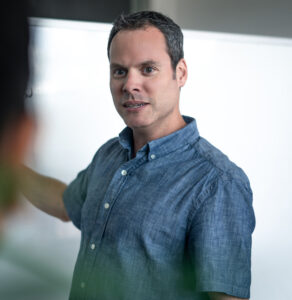
Article
Why Designers and Engineers Should Work Together to Develop Your Next Product
For successful products, design needs to inform engineering, and engineering needs to inform design. Learn how to achieve this synergy on your next project.
Design and R&D leaders often think about the product development process in a linear way. First, they come up with an idea for a new product. Then, they generate a marketable concept — either by engaging a design firm or by working with their internal design team. And finally, they bring the completed design to a contract manufacturer or their internal engineering team to make it a reality.
This is not the best way to increase your product’s odds of success.
A siloed approach to product development comes with at least two significant risks. You could end up with a beautiful design you love only to find out it’s impossible to manufacture. Or, key elements of your design could get lost in translation when it’s time to pass the concept off from the design team to the engineering team.
In both of these scenarios, your final product is likely to be a lackluster shadow of what it might have been. That’s why we approach product development holistically — with designers and engineers working collaboratively toward the same goal.
The Symbiotic Nature of Design and Engineering in Product Development
To achieve product success, design needs to inform engineering, and engineering needs to inform design. Period. But this can be challenging to achieve since designers and engineers serve distinct functions, often approach problems from opposite points of view, and usually have different requirements and goals.
What Product Designers Want
Designers want to create concepts that draw users in and meet their latent and unmet needs. As such, their design choices are geared toward:
- Creating a positive and memorable user experience that sets your product apart from the competition.
- Incorporating your company’s brand into the product through thoughtful and consistent design choices (whether or not you have an official design language).
- Ensuring your product looks innovative and modern while feeling ergonomically pleasing.
- Generating “must-have” enthusiasm for your product.
However, if designers don’t intentionally think about your product’s engineering constraints, they could create a beautiful concept that looks great in theory but falls flat in practice.
For example, one client came to us for help developing a concept another firm designed. The design was beautiful and exciting — and it had already captured the attention and approval of the client’s CEO, the executive leadership team, and the marketing department.
There was just one problem. When we started engineering the solution, we found that the designers hadn’t considered the size of all the components the product required. They dove right into creating a cool concept without factoring in the limitations of the product’s casing. This required us to refine and modify the design to make it work — which was disappointing and embarrassing for the client since they had already shopped the concept around to their stakeholders.
What Product Engineers Want
Engineers are more concerned with function than form. So generally speaking, they’re much more interested in:
- Ensuring your design is feasible and can stand up to the demands of mass production and manufacturing.
- Crossing every regulatory “t” and dotting every “i.”
- Choosing the right mix of COTS and custom parts to maximize your product’s functionality and longevity.
- Keeping your product’s total cost within budget.
When engineering or contract manufacturers focus solely on these objectives, they tend to strip the product design down to the lowest common denominator to simplify the development process.
For example, we’ve worked with clients who have engaged our services to conduct user research, create conceptual designs, and produce user-tested, proof-of-concept prototypes. But then, due to cost or internal politics, they take our design to a contract manufacturer (CM) or their internal team for development.
Unfortunately, what often happens is that the CM or internal team eliminates essential parts of the design — like removing custom surfacing in favor of a smooth cylinder — without realizing those design choices were made specifically in response to user feedback. Then, when the product reaches the market, they wonder why it doesn’t resonate with users the way our initial research showed it would. It’s a classic case of being penny-wise and pound-foolish.
3 Ways to Ensure Your Product Achieves Design and Engineering Synergy
There’s a natural tension between design and engineering because each team is working toward its own important and worthy goals. But frankly, those goals are often diametrically opposed. And that makes it hard to determine the best path forward.
The best way to solve this dilemma is to hire a dedicated team of designers and engineers who:
- Care about achieving your product’s business goals first and foremost.
- Understand each other’s objectives and the tradeoffs they’ll need to consider to get to the best possible solution.
- Work together toward finding the “sweet spot” that will result in your product’s ultimate market success.
- Are aligned around high-level success drivers to help them make good decisions and tradeoffs about your product in every stage of development.
Here are three ways to safeguard your investment.
1. Hire a Development Firm That’s Invested in Your Product’s Success
A good product development partner will be passionate about understanding your overarching business objectives and the fundamental problem you’re trying to solve.
To that end, they’ll:
- Provide comprehensive services that begin with a kickoff and information-gathering session and in-depth strategy phase.
- Base design and engineering decisions on user research and testing, not design trends or whatever is easiest to manufacture.
- Thoroughly validate and test your design’s prototypes before finalizing your product’s manufacturing specifications.
When you’re selecting a product development firm, make sure to pick one that won’t stop until they develop a product that’s functional, well-engineered, innovative, on-brand, and special enough to set you apart from the competition.
2. Ensure Your Firm Knows How to Navigate Design and Engineering Handoffs
If hiring a comprehensive product development firm isn’t in the budget — or you have other reasons for working on design and engineering separately — be especially mindful of how information gets transferred from one party to another.
When our clients need to take design or engineering elsewhere, we provide thorough documentation of our work and we’re willing to meet with the other team to discuss how and why we made the decisions we made.
3. Keep Your Product Development Firm On Deck for Ongoing Advice and Guidance
Even when you do need to take your custom design to a contract manufacturer for development, don’t wash your hands of your design firm. Again, manufacturers may not understand all the nuances of the design choices that your design firm made. So before they make any adjustments or modifications to your product’s design, make sure they check in with the designers who originated your concept.
We’ve worked with clients who have taken our designs to contract manufacturers, only for the CM to change the location of details like knobs, buttons, and levers. Thinking these modifications were no big deal, they didn’t bother to prototype the new design. And unsurprisingly, they ended up manufacturing a product that wasn’t quite right. This resulted in a loss of investment that the client could have easily avoided.
We want to help clients achieve market success, and we’re willing to work out an arrangement to make that possible — even if we don’t do all the work ourselves.
Maximize Your Product Development Investment: Prioritize Design and Engineering From Day One
Collaboration between designers and engineers is the key to unlocking your product’s full potential. However, this type of collaboration is rare in the product development world. That means you’ll need to champion the value of integrated design and engineering if you want your product to be as successful as it can possibly be.
The best way to set your product apart and achieve market success is to hire a product development firm like M3. Our team of talented designers and engineers knows what it takes to bring innovative, memorable, and functional products to market.
We may not be your cheapest option, but thanks to our unique design and engineering capabilities, we just might be your most lucrative one. So let’s talk.





